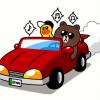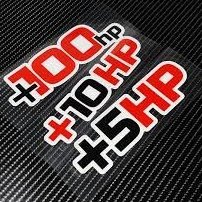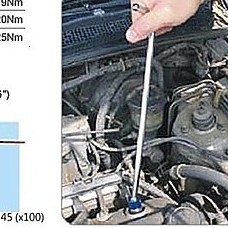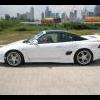Search the Community
Showing results for tags 'congestion'.
-
This is the way to encourage more to switch to public transport but to some 80+ people in one particular cabinet, this would be raiding the reserve! Germany Experimented With Unlimited Train Rides For $9, Here’s What They Found Earlier this year, Germany was looking for a way to reduce the nation’s dependence on energy consuming cars, and decided to try something bold: it offered a monthly train ticket for €9 (S$12.55 at current exchange rates). The ticket entitled users to access the entirety of Germany‘s rail and public transit networks, with the exception of high-speed trains. The hope was that the scheme would encourage drivers to take train trips instead of using their cars as energy woes threaten to impact the country following Russia’s invasion of Ukraine. Part of a relief package, the program will soon end and, although more thorough research is still underway, early findings suggest that the scheme was a measured success. Firstly, it proved very popular with the population. The New Statesman reports that German rail companies sold 38 million tickets over the last three months, which amounts to about half of the nation’s population. That popularity was actually a bit of an issue at first, leading to packed trains and stations as companies struggled to keep up with the newfound demand. According to Vox, ridership rebounded to pre-COVID levels, which was good news, but it only reduced car trips marginally. Studies in Munich found that congestion fell by about three percent. That’s because most people used the trains for vacations and for trips they might not have otherwise taken. Still, that meant that some elderly people and others with low income were able to take trips that would have been out of their reach. In addition, researchers found that during the trial period, 35 percent of people used trams and buses more, and 22 percent used public transit for the first time, about a quarter of those people using it four or more times per week. Traffic data from Tomtom, meanwhile, showed that congestion lowered in 23 of 26 cities it studied during the nine-euro-ticket period. According to riders, though, the biggest advantage of the ticket was how it simplified travel in Germany. Whereas German rail travelers tend to have to navigate many fares and complicated routes, the single ticket price meant that riders could easily jump from train to tram to bus where necessary. “The ticket shows that people want to use public transport — when it’s easy to use and when it’s affordable,” Lukas Iffländer, the vice chairman of Fahrgastverband Pro Bahn, a passenger association, said. The concept also revealed some weaknesses in Germany‘s rail network, pointing to areas that are underserved by transit and others where transit doesn’t run when it might have been useful, such as late at night. The trial period may have been undercut, too, by subsidies for fuel that happened at the same time. Although the price of transit was heavily cut down by the government, so was the price of gas, which may have led some drivers to wonder, “Why bother with transit?” “It’s not sufficient if you only support alternatives to the car, but you have also to be more restrictive towards the car,” said Frederic Rudolph, head of the T3 Transportation Think Tank.
- 30 replies
-
- 10
-

-
.png)
-
Full Story Fail!
-
- 11 replies
-
- Traffic
- congestion
-
(and 1 more)
Tagged with:
-
- 26 replies
-
- congestion traffic control er
- traffic
-
(and 4 more)
Tagged with:
-
It may be less than a smooth ride for commuters using roads in Rochor, Newton, Orchard, MacPherson, Geylang and Thomson over the next eight to 10 years. Construction of five major infrastructural projects will take place over the next decade, and of these, two or more will be converging in these areas from next year until 2022 or so. These are transport and power projects that involve deep excavations, which means commuters can expect road diversions and traffic disruptions. The projects are: the Downtown MRT line, Singapore Power's (SP) Transmission Cable Tunnel, the Thomson MRT line, North-South Expressway, and the Eastern Region MRT line. Source: http://www.straitstimes.com/breaking-news/...ojects-20120926
-
how can adding more buses, more frequency will ease congestion? isn't adding more vehicle to the road will result the opposite? --- New buses to be added to 26 routes to ease congestion By Dylan Loh | Posted: 13 September 2012 1246 hrs SINGAPORE: From Monday, commuters can expect less crowded buses and more frequent arrivals as the government rolls out its Bus Service Enhancement Programme. New buses will be added to 26 routes with heavy ridership during the morning and evening peak periods. By the last quarter of 2012, commuters on another 25 routes will benefit from the addition of new buses. That means by December, over 50 routes will be beefed up, as more than 90 buses in all are added. The additional buses will also serve five new routes, which will be introduced by year-end. - CNA/xq http://www.channelnewsasia.com/stories/sin...1225759/1/.html
-
Every few days we have new threads on discussions on COEs, how to reduce Congestion by having some way to limit others from buying car or drive. It involves along the lines of make it more expensive to own a car, restriction by min downpay, & even how many cars allow per family etc. At the end of the day, many will not admit it, they wish less people will not buy car or drive in Singapore, so they themselves can get to drive without congression. Of course they will also 'justify' why they should drive more than others, be it they are rich, having young kids, elderly parents etc. So how about no suggestion on why others should not drive or restrict car ownership to ease Congestion, but rather, how, ourselves can do to ease Congestion. I fully expect this to be a rather quiet thread but lets see. Let me start first: Some of what I do, or will do: 1) I can walk when the distance is not too far. 2) I carpool when possible. 3) I can take public transport if where I am going is not convenient to drive (or chances of Congestion), like to the stadium on matchday. 4) I can have a no car day a week, where I will not drive to work or something.
-
The MRT Circle Line opened fully on 8 October, promising to bring even greater convenience to residents in the south-west, where the latest connection serves. However, it appears that even with the new MRT line, it just isn't enough to cope. OK, we have to put it into context. The Straits Times attributes the crowds to unexpected demand when the stations first opened. However, the point still stands that, depsite all the efforts, Singapore's public transport is still unable to keep up with the rapidly rising population. It puts commuters in a bind, because it feels like Singaporeans are being increasingly squeezed out, whether on the roads or on public transport. A thread has popped up on MyCarForum, sparked by a letter to The Straits Times (again) from a commuter who claimed to have sold his car when the Circle Line opened. And it raised an interesting question: Do you think our public transport is good enough to replace private transport for most people as of yet? It most certainly is an interesting topic for debate and discussion.
-
Among the whole long list of anti-social behaviour manifest within drivers on our congested roads, there is one particularly abhorrent bad habit on the road that leads to gnash my teeth in frustration. Rubbernecking. (Yes, there is such a word). In our context, rubbernecking is derived from the action involved when a kaypoh road driver practically cranes his neck 180 degrees to get a long and lasting view of something that has caught his or her eye. In the process, said driver will slow his or her car down to a crawl so that they may ogle at whatever caught their eye in the first place. Usually, this is a road traffic accident of some sort. This behaviour gets even more deplorable when it takes place on the other side of the road from the actual accident. Don't the drivers realise that by slowing down to stare they are actually creating jams out of nothing? Don't they realise that by slowing down they are causing the very same jams that they have been sitting in just moments before? Don't they realise it is rude to ogle over some other person's misery? Don't they know that for those very few seconds that they have their curiosity enraptured that they are increasing the risk of causing another accident? And above all, the reason this gets me so riled up is that this behaviour causes traffic jams which would have been avoidable by simple discipline! It is not a road traffic accident which may occur for blameless or blameworthy reasons. It is not a natural congestion caused by peak hour traffic and too many cars. The reason why other drivers behind are forced to sit out in a bad jam wasting their time is simply because of some drivers trying to satisfy their morbid curiosity to liven up their dreary lives! Talk about selfish!
-
Recently, I spent a weekday afternoon running errands around Singapore. Before the journey, I was expecting a leisurely afternoon drive to and fro my various destinations around the Western & Central parts of our island. After all, it was off peak hours so how bad could it get? Well, Murphy's Law decided to interfere and that leisurely afternoon I envisioned never materialised. The first sign that things were not going to be quite so fuss-free was the rain. It started out as a constant drizzle and varied in magnitude throughout the afternoon; never ceasing for even the briefest moment. Then there were 2 accidents, one along the Expressway and the other near the first exit I had to utilize. Traffic was slow moving and it took a whole 15 minutes to clear the exit. Effectively, the 2 traffic accidents doubled my travel time to my first stop. After running the first errand, I headed out towards my second stop. This time, I carefully planned a different route to avoid the congestion caused by the accidents and optimistically thought that I could still end the day on time. But a total of 3 road works on the way to my second destination meant additional delays and slow moving traffic. Thanks to all the delays. By the time I left my second destination for the third, it was already 5pm and traffic was gradually building up. And finally, when I chose to depart my third destination for home; horrors of horrors, there were more road works! This time, the works were "strategically" placed near the car park exit causing a tail back and congestion all the way into the depths of the underground car park. And I continued crawling home in peak hour traffic. So, as luck would have it, an afternoon of leisure morphed into a tiring and stressful day out stuck on the roads. As our weather gets worse over the coming months, I guess it is a timely reminder to drive safely and avoid being a victim of all the road hazards around.
-
Amongst all the congestion on our roads, one particular expressway stands out for being more congested for far longer hours than any other road. Every driver knows that the CTE is notorious for its jams that can last way past 8pm. And despite whatever measures taken, like increasing ERP or undertaking road widening, the CTE remains pretty much a misnomer of an expressway. That is, an expressway with non-express speeds. Ask around and there will be many theories proffered by different road users to explain the great CTE congestion. One popular theory (especially among my biker friends) is that the jams are caused by CTE's numerous inclines. And Singaporean drivers, being frugal with their fuel, do not accelerate more upon coming to an upslope. What happens is a "wave effect"; where you see a clustering of vehicles slowing down on the upslope and a gradual spacing out of cars on the downslope. This slowing down effect is compounded over the number of vehicles and hills such that eventually, some drivers have to tap on their brakes to avoid rear ending the car in front. This further compounds the effect and eventually creates jams when there are sufficient number of vehicles. A slightly less complicated theory derives from the fact that CTE serves a particularly populous part of Singapore - Ang Mo Kio. Add the fact that the population density is high (substantial HDB estates as opposed to landed housing) and tends to be doing decently well (HDB prices are generally higher in Ang Mo Kio) and you have a huge pool of car owners who need to use the CTE. The sheer numbers of drivers cause the congestion. The final theory I have come across attributes the congestion on CTE to its expressway design. Advocates of this theory will point out that in certain stretches of the CTE where jams are the worst, there are just too many entrances and exits in quick succession. As vehicles switch lanes to exit or enter the expressway, they have to brake or will cause others to brake or slow down. This disturbs the smooth flow of traffic and causes congestion. This is compounded by the fact that there are quite a few entrances or exits that coincide on the expressway - meaning that vehicles enter onto the expressway in a lane shared by those trying to exit the expressway. This makes entering or exiting the expressway more difficult and aggravates the disruption effect of vehicles entering or exiting the expressway. My personal take is that I favour the last theory. This is based on my personal observations of how traffic flows on the CTE as well as the fact that AYE is also the most congested at the stretch where there are 3 exits in quick succession (Clementi Ave 6, Ave 2 & Clementi Road). What is your theory on the CTE jam?
- 7 comments
-

Traffic congestion at AYE T.Blangah exit from City
Bluepica posted a topic in General Car Discussion
Usually I use this road on Friday evening to get to VVC. The congestion usually start before the exit. The main reason I see is, criss-crossing of traffic right after the exit. Traffic from Keppel road trying to negotiate to enter the viaduct to West Coast Highway (usually big-mama (trucks and trailers)) and traffic from AYE trying to negotiate to Telok Blangah road.- 1 reply
-
- Traffic
- congestion
- (and 4 more)
-
Warning: This article is intentionally biased and opinionated. If you are too uptight to see the lighter side of things, please click the back button on your browser and select another post to read. I am sure that there are many things that irritate, frustrate and tick us off when we drive on Singapore roads. Here is the top 5 list of motoring related things that get me just that little bit hot under the collar. 5. Leeches Largely harmless but very irritating, leeches are non-drivers who believe that drivers owe them a duty to send them home. Now, this does not include close friends or family members, just those acquaintances who insist on hitching a ride even when it is out of the way. Now, I bought my car so I can save on traveling time. A MRT ride home takes 45mins from town, a drive takes 25mins. What appears as a slight 10min detour actually significantly erodes into the purpose of buying a car. Leeches fail to understand that sending them home is a FAVOUR not a DUTY. Sending them home means I am a nice guy. Not sending them is hardly selfish. 4. Road Hoggers Do I really need to say more about this unique breed of motorist? This motorist lives in a world of his own and is oblivious to others around him. Crawling comfortably at his own pace along the fast lane of the expressway and ignoring the tailback of vehicles behind him. Sometimes I really wonder, do they have impenetrably thick skin? How can someone be so unabashedly inconsiderate? Do they feel no shame, holding everyone else back, slowing everyone down? It is hardly surprising that road hoggers deserve a spot on my list. 3. Poor Carpark Design Another major irritant. Now, this is not because I am a kayu driver who has a problem navigating poorly designed carparks. This irritates me because designing a good carpark is not rocket science. You don't need any special skill or talent. You just need to use your brain and think about it. I often get the feeling that if the designer or architect had bothered to even think it through just that little bit more, the carpark would definitely have been much better. Instead, the carpark often seems to be an afterthought, designed by some unpaid intern. Anyone working as an architect or developer care to tell me why? 2. Congestion/Bad Traffic Bad traffic. I am sure this is a common peeve among motorists everywhere. No amount of ERP or measures by the government seem to help. There seems to be congestion at all sorts of places, occurring for a multitude of reasons. Being stuck in a jam is definitely no fun, making this common gripe number 2 on my list. 1. 'Kiasee' Motorists This type of motorist errs on the side of caution just that little bit too much. He jams on the brakes the moment the car in front so much as taps on the brakes. He insists on leaving more than the required safe distance between vehicles. He slows to a crawl before taking a slight bend or taps on his brakes repeatedly while making a turn. To be safe, when approaching a fixed position speed camera, this motorist slows to way below the mandatory speed limit. Being stuck behind one of these motorists, especially during traffic congestion, is pure torture. Agree, disagree or have your own pet peeves to share? Do drop a note in the comments section.
-
- motorists
- singapore roads
-
(and 3 more)
Tagged with:
-
quote: ST online Dec 14, 2008 "More say ERP helps with congestion WHEN a new set of Electronic Road Pricing (ERP) gantries begin operation, a chorus of complaints is heard and jokes - ERP gantries drawn above lift doors - are circulated freely on the Internet. But the reality is that more Singaporeans now believe that this means of congestion control actually gives them a smoother ride to work. About 26 per cent of drivers polled this year said ERP had reduced traffic compared to 15 per cent last year. Read Maria Almenoar's full story in Monday's edition of The Straits Times." This news report really takes the cake. 26% say ERP reduced traffic.... KNN, so why don't they say 74% say it doesn't? No wonder we still number 144 in the Press Freedom index. Flip here flip there like our prata man http://www.rsf.org/article.php3?id_article=29031
-
Hi guys and gals. I have just emailed a letter to the straits times. I tried to think about it from various viewpoints, and although it's not all encompassing, it should cover some of the main issues for both the people and the government on viewpoints for the three issues. Let me know what you guys think of the ST-unedited version. I have been reading with amusement the excuses LTA has given to increase the number of gantries and raise ERP rates. The fact is, many people still drive to work because of the lack of incentives not to do so, as well as improper use and lack of proper of dis-incentives. LTA should not be working alone, but in tandem with other government agencies to control congestion. As the LTA (or ROV to be more precise) stated when it was first implemented, the ERP system was initially designed to even out traffic flow by spreading traffic out across the various routes. So why does the LTA erect more gantries and charge people when they change their routes? If the alternative routes start getting congested, then the charges at the main route should be reduced to
- 21 replies
-
- Congestion
- Vehicle
-
(and 1 more)
Tagged with:
-
Transport grievances one hot issue at dialogue session By Asha Popatlal, Channel NewsAsia | Posted: 07 October 2007 2003 hrs SINGAPORE: Transport grievances were one of the main issues dominating a dialogue session held after Transport Minister Raymond Lim's community visit to the Thomson Division. "We don't mind, as vehicle owners, to pay increased ERP (fees). But we are frustrated when we pay the ERP (fees), we don't see any ease of traffic flow on the CTE," complained a resident. The answer? It may be frustrating, however there is no one magic solution but a range of measures adjusted over time as the situation changes. Mr Lim explained: "As a first step, we will do what we call traffic engineering solutions. So if you look at the Central Expressway, we have widened it through the years and only recently we did it again. "What's the problem here? Let's say we widen the road. When we first widened the road, the traffic might improve. When it improves, what happens? People who previously didn't drive on that road, the Central Expressway, will now drive on it. "So, some say, 'build more roads'. Yes, build more roads, that will help. Some say, 'better public transport'. Yes, better public transport will also help. But at the end of the day, you also still need this traffic management, which involves not just the ERP, but as you know in our system, we also have COE." But it wasn't just about the ERP. A whole range of transport issues came up during the dialogue session. There were suggestions ranging from having premium bus services to 24-hour senior citizen concession passes. There was also a suggestion to have the Public Transport Council (PTC) review public transport fares only every four years, just before the elections. But, Mr Lim said: "If we freeze the whole thing for four years - no fare increase - the pressure will say, 'why not extend another four years?' The experience of other countries is that the minute you allow the fare increase to be politicised, that over time, the service of your bus standards goes down. If they can't get these returns to renew the bus fleet, the bus fleet will start to shrink and as the bus fleet starts to shrink because they don't replace it, there will be more and more overcrowding. So the situation gets worse and people will complain." - CNA/ir --------- he's merely lip sync-ing everything we all know and predictable.












